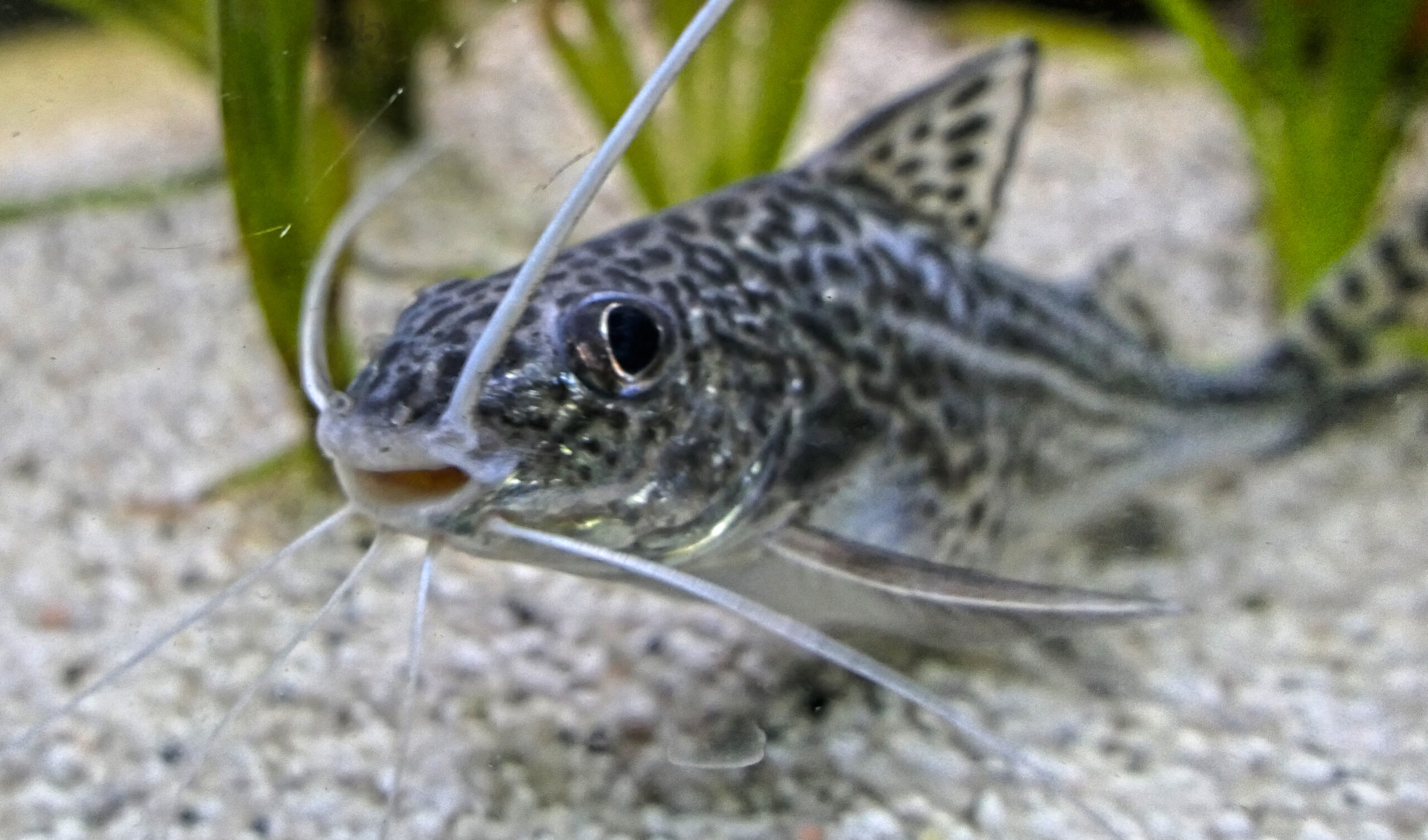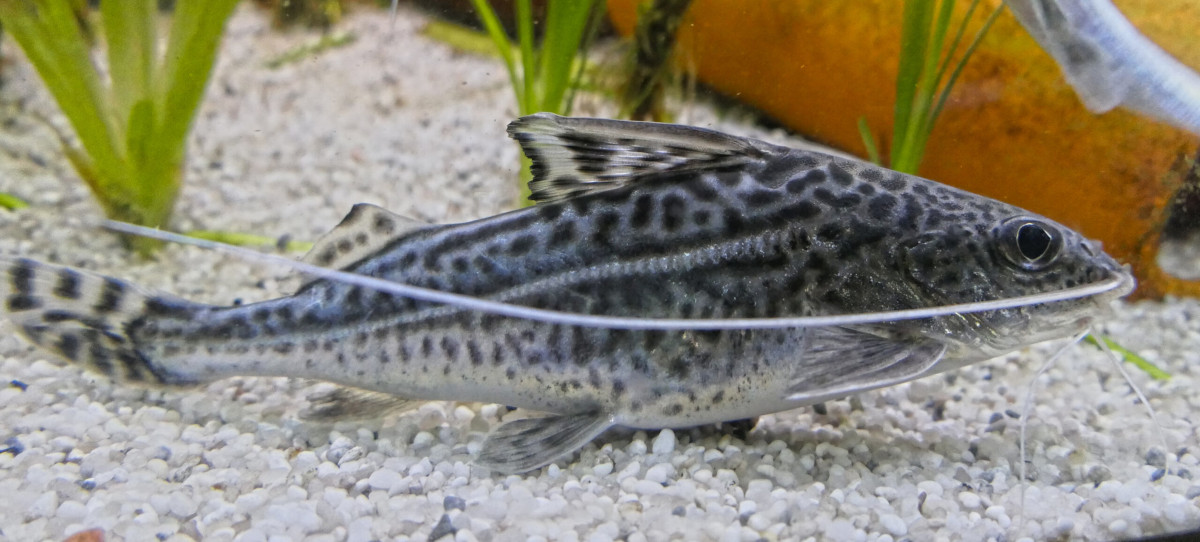Pictus Catfish
The Pictus Catfish, Pimelodus pictus, is a distinctive, spotted species of aquatic life. This vibrant and enchanting fish species with its long barbels or ‘whiskers’ adds an element of intrigue to your aquarium setting.
The energetic Pimelodus pictus proves an excellent inclusion to a large aquarium shared with peaceful, medium to large-sized species. It’s a coveted choice among fish enthusiasts for years due to its lively nature.
- Experience Level: Beginner
- Hardiness: Moderate to Hardy
- Minimum Tank Size: 75 gal (285 L)
- Maximum Size: 5 inches (13 cm)
- Temperament: Peaceful
- Temperature: 75 – 85° F (24 – 29.4° C)
- pH Range: 7 – 7.5
- Water Hardness: 5 – 15 dGH
- Diet: Omnivore
Table of Contents
Introduction
Size and Appearance
Care Guide
Tank Mates
Diet and Feeding
Breeding
Hailing from the Pimelodidae family, the Pictus Catfish originates from the Amazon River Basin. This species is typically located at the bottom of fast flowing, shallow freshwater bodies in countries like Brazil, Peru, Columbia, and Venezuela.
An Austrian zoologist and ichthyologist, Franz Steindachner, was the first to detail the attributes of this breed after joining the Hasssler expedition to South America in 1871.
Though Pimelodus pictus are omnivores and scavengers ready to consume anything that fits in their mouths, they are not hostile hunters. They usually don’t chase smaller fish unless they are famished and unable to locate food.
Distinguished by their active swimming habits, Pictus catfish have a playful demeanor that is sure to amuse budding hobbyists when compared to their more peaceful relatives.
Size and Appearance
The Pictus Catfish measures approximately 5 inches long with a uniquely sleek body. Unlike many other species of its kind, these fish are devoid of external scales. The Pictus Catfish showcases a sparkling light silver hue with dark specks uniformly spread across their bodies, though their bellies bear fewer spots.
The tail and back fins of the Pictus Catfish are semi-transparent and dappled with black spots. Their dorsal fins are a little bit more transparent than their tail fins, adding to their striking appearance.
The standout feature of Pictus catfish is undeniably their barbels, which are as long as their bodies, extending to their tail fins. These ‘whiskers’ give this breed their unique “catfish” look, making them an irresistible attraction in any communal aquarium.
These barbels offer Pictus catfish an effective tool to navigate murky waters in their native territory and discover their surroundings. Observing these barbels sway as your fish flutters around your aquarium offers an amusing spectacle!
Like most of its counterparts, a Pictus catfish has a forked tail and a large, downturned mouth. The physical differences between male and female Pictus are negligible. The females may just be slightly larger and rounder when they reach sexual maturity.
Compared to sought-after aquarium favorites like the Otocinclus, the life expectancy of a Pictus catfish is relatively long, ranging from 8 to 10 years.
Care Guide
- Minimum Tank Size: 75 gal (285 L)
- pH Range: 7 – 7.5
- Water Hardness: 5 – 15 dGH
- Temperature: 75 – 85° F (24 – 29.4° C)
- Lighting: Low, diffused lighting
- Substrate: Fine sand/gravel
- Brackish: No
- Water Flow: Weak/Low
- Tank Region: Mainly bottom
Caring for a Pictus Catfish is relatively uncomplicated due to their minimal maintenance needs. These tiny, fast and energetic schooling fish require a minimum 70-gallon tank as they’re used to an environment abundant in exploration space. Housing them in a tank with limited room for motion can cause stress and impact their wellbeing.
To manage the surplus waste generated by Pictus catfish, your tank must be outfitted with an effective, high-power filtration system. Ensuring water parameters remain steady is crucial as this species has a low nitrate tolerance.
Utilize a high-quality hang-on-back filter to maintain the right flow in your tank. This arrangement helps your Catfish stay in optimal shape since they’re accustomed to fast water currents. Regular upkeep is important because of the Pictus catfish’s sensitivity to pollution, so be sure to perform regular, partial water changes every week. Keeping the water clean is vital to prevent the Pictus Catfish from losing their barbels.
Monitoring the water conditions in your aquarium is very important. Regular testing ensures that water parameters stay within the recommended range and provides the Pictus Catfish with optimum living conditions.
A key aspect of Pictus catfish care is setting up the tank correctly. Aim to recreate the natural habitat of these freshwater fish, which typically consist of warm rivers and streams in South America.
Pictus catfish are nocturnal creatures, preferring to live in flowing water amidst dense vegetation. Therefore, a heavily planted aquarium with low-lighting conditions fits perfectly for Pictus Catfish.
A peaceful resting place during daylight hours is important for this nocturnal breed. You can emulate a natural river-like environment using driftwood, branches and roots, and round smooth stones. A fine sand substrate is recommended to avoid injuring their delicate barbels.
We advise using sturdy plants like Anubias, Java fern, and Hornwort that can tolerate low light. These can be attached to the décor, leaving ample space for your Pictus Catfish to swim around.
While certain plants, logs, and driftwood are necessary to provide a comfortable environment for your Pictus catfish, it’s also crucial to maintain an equilibrium between open space and décor. These vivacious fish are swift swimmers and packing their tank with too much foliage, rocks, and driftwood can hinder their space to swim freely.
Your Pictus catfish needs a cave or a log that acts as a daytime hideaway. If your tank houses other Pictus catfish, species of bottom feeders like Plecostomus spp, or other nocturnal breeds, it’s beneficial to provide ample hiding places.
The scaleless Pictus Catfish is mainly susceptible to diseases like white spot or Ich. Moreover, treating them is a challenge due to their delicate skin, which can be sensitive to common medications. Always read instructions carefully before introducing any type of medicine to a tank housing these fish. If you’re uncertain about the dosage, halving the amount is generally advisable.
Regular water testing and changes are necessary to ensure the wellbeing of your Pictus catfish by maintaining water cleanliness.
Take caution when handling these fish. The Pictus catfish’s sharp, serrated pectoral fins can tangle in a net’s mesh. In such cases, using an open plastic or glass container to capture them prevents injuries as the fish struggles to free itself.
Whenever you’re handling these fish, be vigilant to avoid cuts from the spines, which can cause a painful sting akin to a wasp or a bee bite. The automatically disbursed toxin from the mucus that covers the fin spines is relatively harmless, but the resulting swelling and throbbing can be bothersome for a couple of hours.
In the event that you are cut by a catfish spine, immediately clean the wound thoroughly and wait until the cut has completely healed before immersing your hand in the tank water. Untreated wounds can lead to Fish Handler’s Disease.
If you need to transfer the Pictus catfish to another tank for any reason, capture it using a wide jar which will prevent injuries both for you and the fish.
Pictus catfish are exceedingly charming and exhibit a diverse range of behavior. Like its kin, this spotted fish loves to seek refuge beneath plant coverings and eagerly explores rock caves and logs placed at the bottom of your aquarium.
As a naturally nocturnal species, Pictus catfish feel discomfort in brightly lit environments and remain hidden. However, housing them in a dimly lit tank or using plants to create shaded areas will encourage these attractive, speckled fish to swim during the day also. The active Pictus Catfish happily joins other fish at feeding time.
The Pictus Catfish is a schooling species. Although you can keep a single catfish alone, their natural, outgoing behavior can be observed when they are housed in a group of six or more. A solitary spotted catfish in your communal tank will remain hidden during the day and only come out at night once the lights are turned off.
Pictus catfish have seemingly contradictory behaviors, they are timid at times, and playful at others. They tend to reside in the lower half of the tank among caves and logs for extended periods, out of sight. They are energetic swimmers who enjoy fast currents. Observing their playful antics near the filter outlet can truly be a delight.
To ensure the happiness of your Pictus catfish, you need to provide plenty of hideouts in your aquarium where they feel secure and comfortable.
Tank Mates
Attributed to the Pictus Catfish’s peaceful nature, it proves an excellent choice for a communal aquarium. Their potential tank mate list is extensive, as they can coexist harmoniously with any species comfortable in soft water environments.
Though not overly aggressive hunters, Pictus catfish won’t hesitate to consume smaller fish like neon tetras when they see fit. Avoid adding small fish species that could fit into the mouth of the Pictus catfish into the same aquarium. Tetras, Guppies, and other nano fish run the risk of becoming an enticing meal for the spotted catfish.
The following is a broad list of medium-sized fish that make suitable tank mates for your Pictus catfish:
- Blue Gourami Bucktooth
- Tetra Glass Catfish
- Blue Gularis Killifish
- Silver Dollar
- Rubber Pleco
- Angelfish and Discus
- Rainbow Shark
- Tiger Barb
- Red Irian Rainbowfish
- Similar-sized Catfish
- Corys
- Giant Danios
- Opaline Gourami
- Loaches
- Mollies and Larger Platies
Pictus catfish live harmoniously with other catfish like Otocinclus, Plecostomus, and Upside-Downs. However, the ceaseless activity of the Pictus catfish may prove disruptive for slow-moving cichlids or territory-bound bottom feeders.
Avoid housing aggressive species like the African cichlids or the Jack Dempsey fish as they will likely bully the Pitcus catfish.
Feeding Guide
- Diet: Omnivore
- Frequency: Several small feedings per day
- Pellet Foods: Yes
- Flake Foods: Yes
- Live Foods: Yes
- Meat Foods: Yes
- Vegetable Foods: Yes
Feeding a Pictus catfish is generally easy, but understanding their natural diet will help you provide the right nutrition.
Like all catfish species, Pictus catfish are omnivores and eager scavengers. Their varied diet includes plants, algae, and protein. You’ll need to ensure they receive a balanced diet.
You can feed Pictus catfish both freeze-dried and live food. Frozen foods, flakes or pellets are easier to manage. Provide them with algae wafers and frozen or dried treats like Daphnia eggs, bloodworms, brine shrimp, mosquito larvae and frozen plankton as part of their diet.
Besides pellets and dried food, Pictus catfish require quality protein. They enjoy live foods which should be incorporated into their meals at least once a week. Here are some good live food options:
- Live blood worms
- Beef heart
- Tubifex worms
- Glass worms
- Brine shrimp
- Fish
Breeding
While caring for Pictus catfish is relatively simple, breeding this egg-laying species in an aquarium can be challenging, even for experienced fish hobbyists.
The spotted catfish available in pet shops, aquarium stores or online are generally bred in captivity. They are collected as eggs or juveniles from their natural habitat and nurtured in tanks until they grow to an approximately 2-inch length that is suitable for shipping.
Identifying the sex of the Pictus catfish poses the first challenge due to their similar appearance. Moreover, this species requires access to open water to reach sexual maturity.
In order to increase your chances of successful breeding, you need to accommodate a group of Pictus catfish in a large spawning tank. You might need to alter the water chemistry by adjusting the water temperature or pH to stimulate the fish to spawn.
Unfortunately, information regarding their breeding habits is scant, making the breeding of Pictus catfish in captivity quite a slim possibility.



